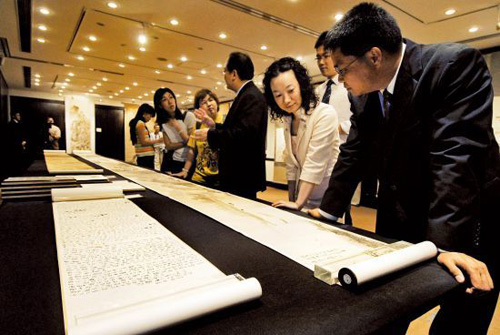Auction houses must adapt to changing art market

Chinese art auction houses have found it increasingly difficult to adapt the traditional business model to the pace of the market’s development and transactions. An innovative transformation is needed.
From 2003 to 2012, auctions of Chinese art performed well in a bull market. Although there were ups and downs, the rising trend didn’t change. Even during the shocks of the global financial crisis in 2008, the Chinese art market quickly rebounded beyond all expectations. However, a profound adjustment in the market has been underway since 2012 and no positive signals have appeared. So what is the current situation?
This change is actually a normal periodical adjustment that followed a round of asset revaluations. The Chinese economy and investment conditions indicate that alternative assets, such as antiques, art, stamps and coins, are going through the same process of asset revaluation as financial and real assets, like stocks, land, real estate and bulk commodities.
A decade of rapid development in the Chinese art market was made possible by government deregulation, particularly in regard to the establishment of auction houses. So a number of art companies have sprung up in China.
Since 2002, the exchange rate of US dollars has depreciated. In 2005, China had a huge trade surplus and China’s credit has rapidly expanded since 2008. The overall economic situation has strongly promoted the revaluation of art, which can be seen as a bubble in the asset price of artistic works. This is the time for the Chinese art market to carry out profound adjustments.
This round of adjustment in the Chinese art market reveals problems on the supply side. According to the latest statistics from the China Association of Auctioneers, China has 436 art auction houses and the annual transaction volume had reached more than 30 billion yuan by the end of December in 2015. It has become increasingly difficult for small and medium-sized auction houses to hold auctions. Also, the polarization in auction companies has become more and more serious. Although the market share of the top 10 large auction houses, including Beijing Poly Auction and China Guardian Auction, fell in 2015, the annual aggregate transaction volume for these 10 houses has remained stable at between 15 billion yuan and 20 billion yuan in the last four years. At the same time, the annual national aggregate transaction volume for art auctions generally remained between 30 billion yuan and 38 billion yuan.
Because quality auction items are scarce, some small and medium-sized auction houses with weaker finances have found it difficult to collect auction goods and have been pushed to the margins of the market. But quality auction goods performed very well.
The structural downturn on the demand side is another reason why the Chinese art market must carry out a profound adjustment. Impacted by the lack of quality and the few new and precious auction goods from the supply side, there are no valuable goods for “old money” to invest in. But if auction companies can provide valuable auction goods, these goods will become popular and driven by the market.
However, many new players who have entered the auction market in recent years have found that it is not as easy to make money in the Chinese art market as some media outlets and experts have suggested.
Chinese auction houses have found it more and more difficult to adapt the traditional business model to the pace of the market’s development and transactions. High operating costs and transaction costs, long trading hours, and low transaction and accounting rates are the main obstacles to auction houses’ further development. This is why Chinese auction houses need to make great efforts in innovation and transformation in order to solve development dilemmas.
The first solution is to embrace the “Internet Plus” strategy actively. Online auctions are not only a powerful method of reducing long-term operating costs and lowering transaction costs, but also a good way to shorten trading hours and improve trading efficiency. From the aspects of providing new experience and cultivating potential markets, the Chinese art industry needs both the traditional business model and efficient online auctions.
The second solution is to explore the “Financial Plus” strategy. In recent years, artistic and financial innovation has mainly focused on products and has not involved enterprises.
In fact, auction houses are not only the best player to innovate in terms of artistic and financial products, but also the optimal investment target for profit-driven investors to participate in the art market.
Ma Jian is from the College of Tourism and Historical Culture at Southwest University for Nationalities.
